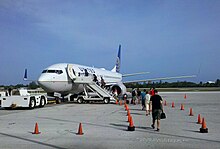
An airline is a company that provides air transport services for traveling passengers or freight. Airlines use aircraft to supply these services and may form partnerships or alliances with other airlines for codeshare agreements, in which they both offer and operate the same flight. Generally, airline companies are recognized with an air operating certificate or license issued by a governmental aviation body. Airlines may be scheduled or charter operators.
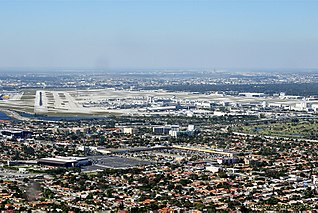
Miami International Airport — also known as MIA and historically as Wilcox Field — is the primary international airport serving Miami, Florida and its metropolitan area with over 1,000 daily flights to 185 domestic and international destinations, including most countries in Latin America. The airport is in an unincorporated area in Miami-Dade County, 8 miles (13 km) west-northwest of Downtown Miami, in metropolitan Miami, adjacent to the cities of Miami and Miami Springs, and the village of Virginia Gardens. Nearby cities include Hialeah, Doral, and the Census-designated place of Fontainebleau.
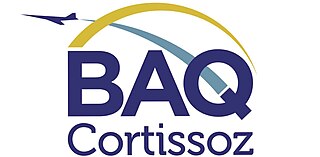
Ernesto Cortissoz International Airport is an international airport serving the area of Barranquilla, the capital city of the Atlántico department in Colombia. The airport is located in the suburban municipality of Soledad. It owes its name to one of the pioneers of Colombian aviation, Ernesto Cortissoz.

Hartsfield–Jackson Atlanta International Airport is the primary international airport serving Atlanta and its surrounding metropolitan area, in the U.S. state of Georgia. The airport is located 10 mi south of the Downtown Atlanta district. It is named after former Atlanta mayors William B. Hartsfield and Maynard Jackson. The airport covers 4,700 acres of land and has five parallel runways which are aligned in an east-west direction. There are three runways that are 9,000 feet (2,743 m) long, one runway that is 10,000 feet (3,048 m) long, and the longest runway at ATL measures 12,390 feet (3,776 m) long, which can handle the Airbus A380. Since 1998, Hartsfield-Jackson has been the world's busiest airport by passenger traffic. In 2023, the airport served over 104.6 million passengers, the most of any airport in the world. Hartsfield-Jackson is also the world's busiest airport by aircraft movements.

Cleveland Hopkins International Airport is a city-owned international airport in Cleveland, Ohio, United States, and is the primary airport serving Greater Cleveland and Northeast Ohio. It is the largest and busiest airport in the state, as well as in the top fifty largest airports in the U.S. by passenger numbers. Located in Cleveland's Hopkins neighborhood 9 miles (14 km) southwest of Downtown Cleveland, it is adjacent to the Glenn Research Center, one of NASA's ten major field centers.
Air Wisconsin Airlines is a regional airline based at Appleton International Airport in the town of Greenville, Wisconsin near Appleton, Wisconsin. Air Wisconsin originally operated as one of the original United Express partners in 1985, and subsequently operated as US Airways Express on behalf of US Airways prior to becoming an American Eagle regional air carrier. Between March 2018 and April 2023, Air Wisconsin operated exclusively as a United Express regional air carrier once again with primary hubs located at Chicago's O'Hare International Airport (ORD) and Washington Dulles International Airport (IAD). This came to an end in April 2023 as the carrier switched to conducting solely American Eagle branded flights, under a new contract with American Airlines.

Great Lakes Airlines was an American regional airline operating domestic scheduled and charter services. Corporate headquarters were in Cheyenne, Wyoming, with a hub at Denver International Airport.

Miguel Hidalgo y Costilla Guadalajara International Airport, simply known as Guadalajara International Airport, is the primary international airport serving Guadalajara, Jalisco, the third-largest city in Mexico. It facilitates flights to and from destinations across Mexico, the Americas, and Europe. It is the largest hub for Volaris, functioning as the airline's primary gateway to the United States. Additionally, it serves as a hub for Aeromexico and Viva Aerobus. Operated by Grupo Aeroportuario del Pacífico (GAP), the airport is named after Miguel Hidalgo, a prominent leader in the Mexican War of Independence.

Ethiopian Airlines, formerly Ethiopian Air Lines (EAL), is the flag carrier of Ethiopia, and is wholly owned by the country's government. EAL was founded on 21 December 1945 and commenced operations on 8 April 1946, expanding to international flights in 1951. The firm became a share company in 1965 and changed its name from Ethiopian Air Lines to Ethiopian Airlines.

An airline hub or hub airport is an airport used by one or more airlines to concentrate passenger traffic and flight operations. Hubs serve as transfer points to help get passengers to their final destination. It is part of the hub-and-spoke system. An airline may operate flights from several non-hub (spoke) cities to the hub airport, and passengers traveling between spoke cities connect through the hub. This paradigm creates economies of scale that allow an airline to serve city-pairs that could otherwise not be economically served on a non-stop basis. This system contrasts with the point-to-point model, in which there are no hubs and nonstop flights are instead offered between spoke cities. Hub airports also serve origin and destination (O&D) traffic.
Eurowings GmbH is a German value airline headquartered in Düsseldorf, North Rhine-Westphalia, and a wholly owned subsidiary of the Lufthansa Group. Founded in 1996, it serves a network of domestic and European destinations and maintains bases at several airports throughout Germany, Austria, and the Czech Republic.
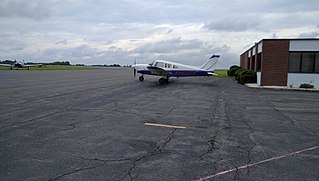
Smith Reynolds Airport is a public airport 3 miles (5 km) northeast of Winston-Salem in Forsyth County, North Carolina. The airport has two runways, and is used for general aviation and flight training. There are currently no scheduled passenger airline flights. Smith Reynolds was once home to the Winston-Salem air show, usually held in September, which drew about 20,000 spectators. There has not been an airshow since 2015. The airport has multiple flight schools and maintenance facilities. Smith Reynolds also has an operational control tower that operates from 6:00 AM to 9:30 PM year-round. INT covers 702 acres of land.

Nursultan Nazarbayev International Airport, alternatively referred by its previous name as Astana International Airport until 2017, is the international airport serving Astana, Kazakhstan, the capital and second most populous city in the country. It is the primary aviation hub for northern Kazakhstan. Regionally, it stands as the second-busiest international air passenger gateway into Central Asia after Almaty International Airport (ALA). The airport is also the second-busiest airport in terms of total passenger traffic, air traffic movements and total cargo handled in Kazakhstan, with ~7,500,000 passengers served annually in 2023, a 25% increase compared with 2022, a new passenger record for the airport. On average, the airport handles more than 200 departures a day.

Quetta International Airport ; is located at Quetta, the provincial capital of Balochistan, Pakistan.It is the second largest airport in the south region of the country and the largest for the province of Balochistan. It is situated 12 km south-west of the city, spread over an area of 35 acres (14 ha). Average scheduled flights were 1332, non-scheduled flights 247, and the total recorded passenger flow was 152,698 in 2007.
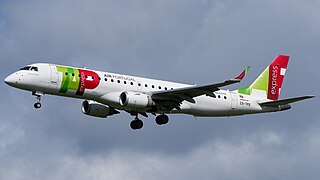
A regional jet (RJ) is a jet-powered regional airliner with fewer than 100 seats. The first one was the Sud-Aviation Caravelle in 1959, followed by the widespread Yakovlev Yak-40, Fokker F-28, and BAe 146. The 1990s saw the emergence of the Canadair Regional Jet and its Embraer Regional Jet counterpart, then the larger Embraer E-Jet and multiple competing projects. In the US, they are limited in size by scope clauses.

Tuzla International Airport ; is an airport located in Živinice near Tuzla, Bosnia and Herzegovina. Tuzla International Airport is the second largest airport in Bosnia and Herzegovina, after Sarajevo International Airport. The airport is known as a low-cost airline hub of Bosnia and Herzegovina, since it is used by people from Bosnia, the diaspora and travellers from neighbouring countries Croatia and Serbia. The airport is a civilian airport and also was a military airbase.

Point-to-point transit is a transportation system in which a plane, bus, or train travels directly to a destination, rather than going through a central hub. This differs from the spoke-hub distribution paradigm in which the transportation goes to a central location where passengers change to another train, bus, or plane to reach their destination.

A transport hub is a place where passengers and cargo are exchanged between vehicles and/or between transport modes. Public transport hubs include railway stations, rapid transit stations, bus stops, tram stops, airports, and ferry slips. Freight hubs include classification yards, airports, seaports, and truck terminals, or combinations of these. For private transport by car, the parking lot functions as an unimodal hub.
Manunggal Air Services was an airline based in Jakarta, Indonesia. It operated charter passenger and cargo services within Indonesia and neighbouring regions. Its main base was Halim Perdanakusuma Airport, Jakarta.

Jinnah International Airport, formerly Drigh Road Airport or Karachi Civil Airport, is Pakistan's busiest international and domestic airport, and handled 7,267,582 passengers in 2017–2018. Located in Karachi, the largest city and commercial capital of Pakistan and capital of the province of Sindh, it is named after Muhammad Ali Jinnah, the statesman founder of Pakistan. It is one of the oldest airports in the world.
